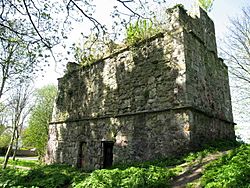St. Mary's Priory (Lothian) facts for kids

Doocot in the grounds of the ruined abbey
|
|
| Monastery information | |
|---|---|
| Other names | North Berwick priory, North Berwick nunnery |
| Order | Benedictine (and possibly later Cistercian) |
| Established | c. 1150 |
| Disestablished | 1588 (last nominal prioress died 1596x1597) |
| Dedicated to | St Mary |
| Diocese | St Andrews |
| Controlled churches | Kilconquhar, Kirkbride (St Brigit's, Maybole), Largo, Largs, Logie-Atheron, Maybole (St Cuthbert's), North Berwick |
| People | |
| Founder(s) | Donnchad I, Earl of Fife |
| Site | |
| Location | North Berwick, East Lothian |
The Priory of St. Mary of North Berwick was a special place where nuns lived and prayed in medieval Scotland. It was located in North Berwick, a town in East Lothian. A priory is a type of monastery, which is a community building for people who dedicate their lives to religious service.
This priory was started around 1150 by a powerful person named Donnchad I, Earl of Fife. He owned a lot of land in the area. The priory was active for over 400 years! It slowly became less important and eventually closed down after the Scottish Reformation. This was a big change in Scotland when the country moved away from the Catholic Church.
The priory received gifts of land and money from important families, like the Earls of Fife and the Earls of Carrick. Over time, a local family called the Home (or Hume) family gained control. They eventually took over the priory's lands as their own.
Contents
When Was the Priory Founded?
Some old books say that Máel Coluim I, Earl of Fife started the priory. However, older documents, called Charters, show that his grandfather, Earl Donnchad I, was the real founder. Donnchad I died in 1154.
A charter from Donnchad I's son, Earl Donnchad II, even mentions that Donnchad I gave land to the priory. Máel Coluim I did confirm all the priory's lands in 1199. Historians think the priory was likely founded between 1147 and 1153, perhaps in 1150.
Who Else Supported the Priory?
Another important person who helped the priory was Donnchad, Earl of Carrick. He was related to the Fife family. He gave the priory control over the Church of St Cuthbert in Maybole. This happened sometime between 1189 and 1250.
Donnchad of Carrick also gave the Church of St Brigit at Kirkbride to the nuns. He also gave them money from a place called Barrebeth.
What Kind of Nuns Lived There?
The Priory of North Berwick seems to have been a Cistercian house. The Cistercian Order was a group of monks and nuns. However, it might have started as a simpler Benedictine house.
A writer named Gervase of Canterbury described it as Benedictine around 1207. Nuns in England often switched to the Cistercian Order because it offered special benefits.
How Many Nuns Lived at North Berwick?
A special letter from Pope Clement VII in 1384 said the monastery had been damaged by war. Its church had even burned down. This letter also mentioned that the nuns were not using the Cistercian style of clothing.
Most Cistercian nunneries had thirteen nuns: a prioress (the leader) and twelve sisters. But North Berwick was much larger! In 1544, it had 21 sisters and a prioress. It still had a similar number of nuns just before the Scottish Reformation. The priory also managed two hospitals, one in Ardross and one in North Berwick.
The End of the Priory
In 1565, the priory's lands were rented out to Alexander Home of North Berwick. His sister, Margaret Home, was the last prioress. A prioress is the head nun of a priory.
On March 20, 1588, King James VI made these lands a free barony for Alexander Home. A barony meant he owned the land and had special rights over it. By 1587, the buildings of the priory were already in ruins.
Who Were the Prioresses?
Here is a list of the known leaders of the priory:
- Beatrice, active around 1375
- Ellen of Carrick, active from 1379 to before 1401
- Matilda of Leys, active from 1401 to 1434
- Mariot Ramsay, active around 1463
- Elspeth Forman, chosen in 1473
- Alison Home, from 1473 to 1525
- Isabel Home, from 1525 to 1544
- Margaret Home, from 1543 to 1562
- Mariot Cockburn, from 1566 to 1568
- Margaret Home (again), from 1568 to between 1596 and 1597
Images for kids


